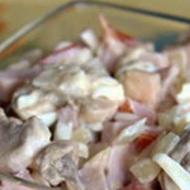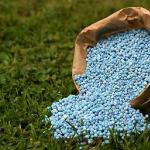
Mealybug. How to deal with mealybug on indoor plants
A mealybug is a sucking insect that is quite simple to detect with the naked eye. It is so named because of white vatoobrazny wax secretions.
Larvae with adult females prefer to suck young shoots and leaves with buds.
These pests contribute to the slow growth of the plant. Insects move quickly regardless of age. They are covered with a powdery wax coating.
Unpleasant acquaintance
The length of the insect is from three to six millimeters. The mealybug is characterized by sexual dimorphism.
Males have wings, well-developed limbs. They are devoid of oral apparatus. Adult males do not eat.
On plants are only females. Their color may be white, light pink or brownish. Most of the representatives of the species have reduced legs or are completely absent.
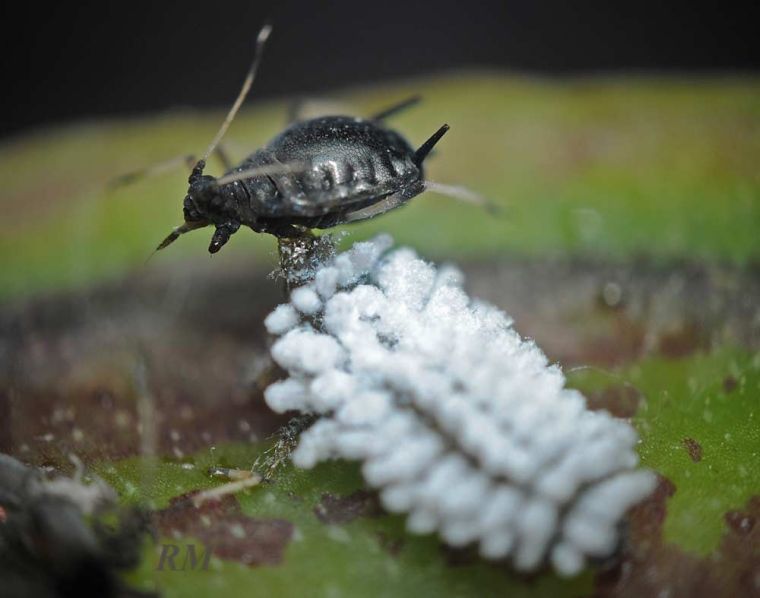
Many of them lay eggs, and females of some species viviparous. Eggs ripen in a special white vatoobrazny facial bag.
The mealybug is a very prolific representative of the animal world. Before laying eggs, many forms are accustomed to leaving the place where they ate, and then hiding in the shelter.
Now in the world there are more than one and a half thousand species of this insect. Most of them live in tropical latitudes. Scale insects harm fruit, technical, ornamental crops and greenhouse plants.
A mealybug is often settled on indoor plants, for example, orchids, violets, ficuses, dragon plants and cacti, therefore it is very important for any gardener to know how to deal with this.
It is impossible to name one main reason because of which a harmful insect appears on plants. Most likely, the mealybug is the result of disturbed keeping and looking after the plant.
For example, if there was a lower temperature, too wet soil, contaminated soil was used, hygiene procedures were ignored, and dead plant parts were removed.
The enemy is already near
About the appearance of the pest can be found if you see it. Also, his presence is indicated by yellow plants with dead leaves, young, deformed leaves that appear, a sluggish appearance.
The next symptom of the lesion is sugary discharge. In addition, plants can be covered with a bloom of a web of old color. The settled black fungus also signals an insect.
Chervets suck the juice contained in the shoots, leaves, buds and thus contribute to the delay of plant growth. Certain species of chervets can affect the root.

Mealybug on the roots of a plant
Insects contribute to the deformation of the shoots, the fall of leaves with ovaries and fruits, cracking of the bark of the trunk and branches, the drying of the branches.
When insects are detected, it is recommended to remove the affected plant in order to prevent their spread. Neighboring plants are at risk of damage, even if they do not have such visible signs as white bloom or sticky secretions.
These plants must be inspected for thirty days every day. Wash the window with the window sill, on which the damaged plant was located, with a solution of soap and alcohol. This will destroy the insects that continue to crawl around the plants.
What plants to his taste?
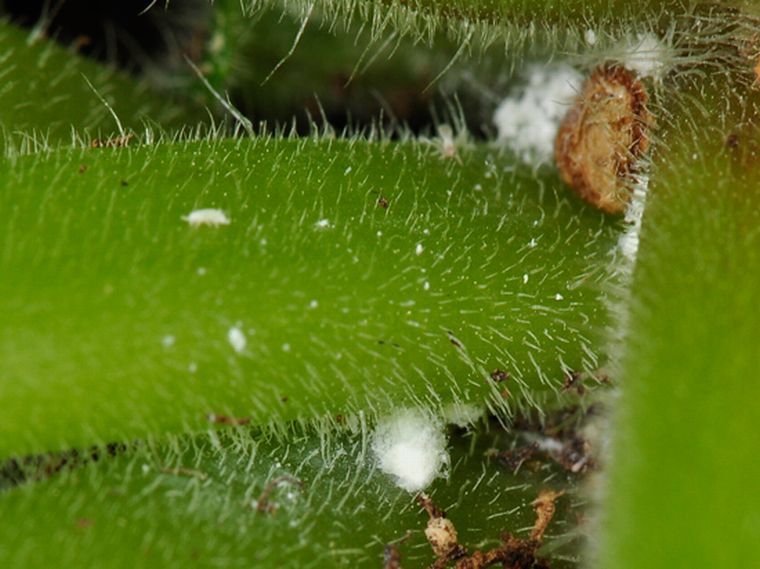
For mealybugs, citrus plants are attractive. In addition, he will not pass by:
- bromeliads;
- cilicus;
- cacti;
- adiantum;
- christians;
- ferns;
- monster;
- ardisy;
- brunfelsia;
- dieffenbachy;
- shefflera;
- poinsettia;
- violets;
- fatses;
- rhododendron;
- cyperus;
- cissusa;
- hippeastrum;
- orchids;
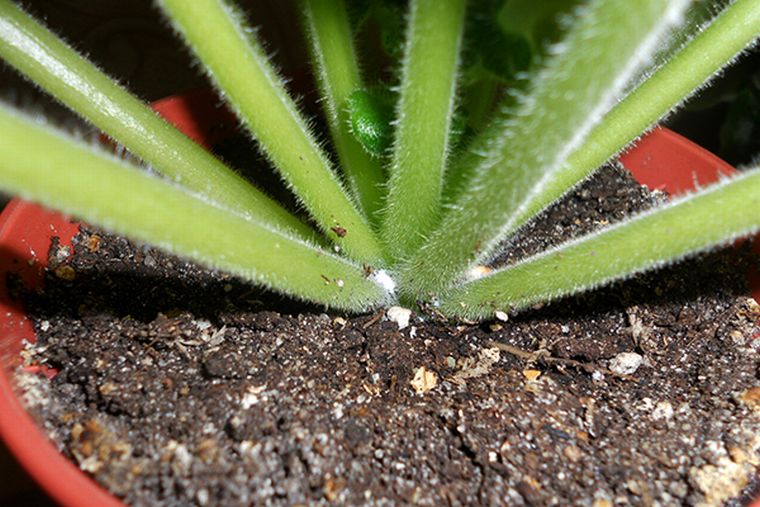
Mealybug likes to live on room violets
Ways of struggle - chemistry to help
It is necessary to begin to treat the affected plants with mechanical processing.
Young sprouts, leaves, root neck, the underside of leaves and their sinuses, buds, flowers, peduncles - these are places of insects.
Lure the worms by increasing the temperature and humidity of the air around the plant.
If the plant is slightly damaged, it should be washed with a solution of soap. This procedure should be performed once every seven days.
The ground part of the small-leaved species is treated with soapy water using a spray bottle. Every thirty to forty minutes, the solution should be rinsed under running water. After several days, the treatment is repeated.
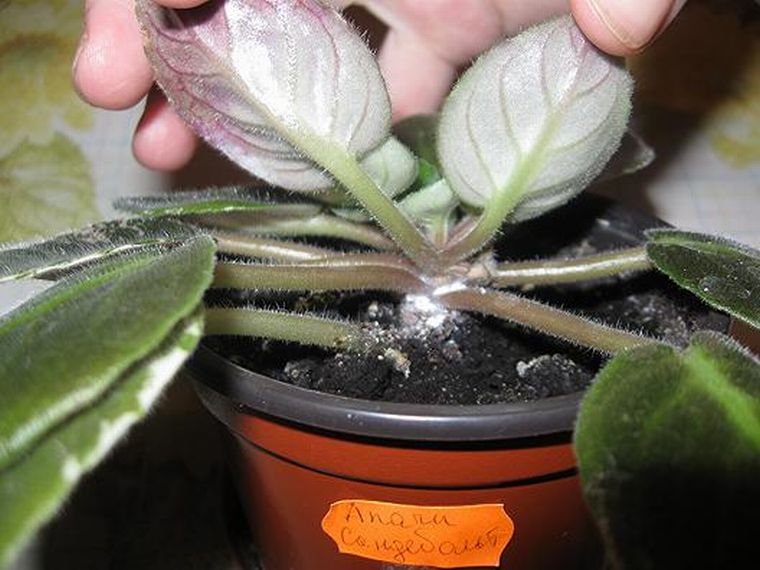
Processing plants from pests
If the described methods of control did not bring the desired result, then it is necessary to use preparations with insecticidal action. These include Aktar with Konfidor-maxi, Aktellik, Vertimek and others. To enhance the effect, take drugs and mix them.
Any drug of choice is diluted in the ratio of 1 gram of medicine per 1 liter of water. The resulting mixture is poured into the soil of the plant. It is necessary to poison all the plants, not excluding not affected flowers.
Water the solution should be the usual way. An excessive amount of the mixture poured in may cause the root system to rot. After seven days, watering is repeated. It is recommended not to reuse the same drug, and replace it with another.
If the mealybug destroys your flowers, there is salvation:
Many growers are in no hurry to use chemistry to control pests, but there are equally effective ways to eliminate pests with the help of natural products:
- Need to take soft wet brush and clean the plant with it. Then it is washed with water, paying particular attention to the underside of the leaves.
- Leaves with stems are allowed to handle onion or garlic juice together with soap once a week; tincture of orange peel or mandarin.
- Plant can be treated with a solution that contains soap and alcohol. To do this, take one teaspoon of soap and wait until it melts in hot water. Then add one liter of water and add one tablespoon of alcohol, which can be replaced with two tablespoons of vodka. The resulting solution is sprayed with a plant. Before this action should cover the soil in a pot. After twenty-four hours, the plant is washed with warm water. Similar treatment is carried out in three to four days.
- In the fight against the b heart helps well. For its preparation take 25-70 g of garlic. It is cleaned and kneaded, and then poured with one liter of boiling water. Infusing this solution takes six hours. Then it is filtered and sprayed with a flower.
- An effective remedy is tincture made from horsetail. This item can be purchased at the pharmacy. A small amount of horsetail is poured with boiling water and allowed to infuse for a couple of days. After this solution is watered plant.
- Its action is famous and olive oil. To prepare it, you need to take one liter of water with two tablespoons of olive oil. Ingredients need to mix. The resulting mixture is applied to the plant with a sprayer.
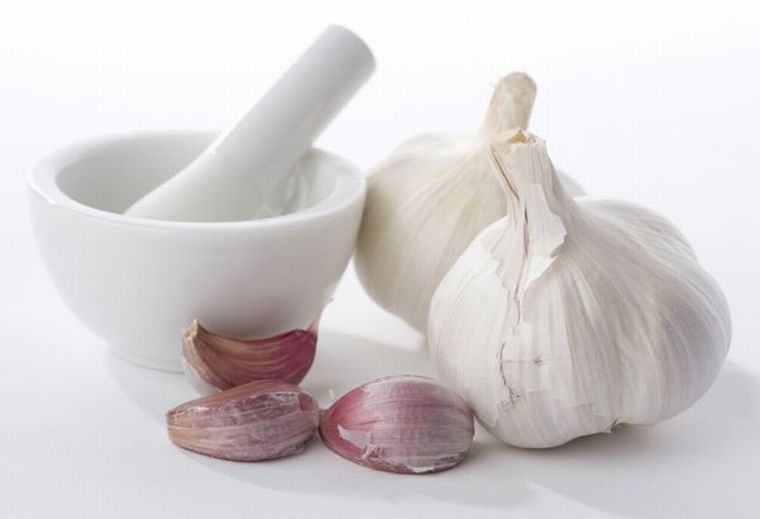
At the grower with the experience the mealybug lives on an orchid - a visual video tutorial for beginners:
Preventive actions
For preventive purposes, you should regularly inspect the plants. It is especially important to do this during the off season.
It is important to know that moisture is unpleasant to this pest, it is an adherent of dry conditions.
To prevent the scarlet from infecting the plant, it must be kept clean and all dried leaves removed. Remember that plants that have clean leaves are less susceptible to pest attack.
Let's sum up
Mealybug is a dangerous pest for a wide range of plants. It has a white vatoobraznuyu shell.
This pest is very prolific. At the moment there are about 1600 species of insect in the world. Most of it is concentrated in the tropics. Insects prefer young plants. They suck the juice, because of what the plants dry out.
The appearance of a worm contributes to poor conditions and maintenance of plants. Its appearance is evidenced by numerous symptoms, for example, sugary excretion and white web.
It is very simple to see a mealybug. He likes to hit citrus plants. Do not hesitate and home.
To overcome the pest use folk remedies and developed chemicals. The effectiveness of the first and second testify the results of processing plants.
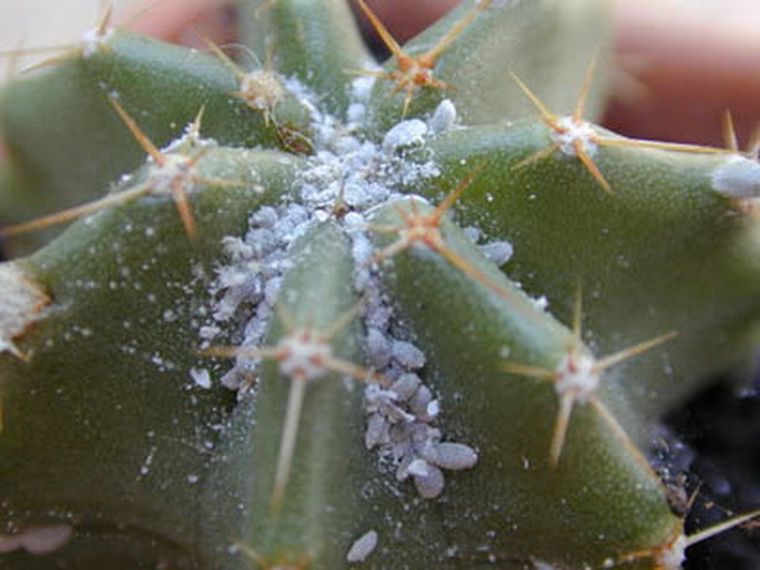
Mealybug on cacti
In order for the plants not to be adversely affected by the worm, they must be followed.
It is necessary to keep the leaves of plants clean and periodically inspect them. Remember that plants that have clean leaves are less susceptible to pests.
- It is noticeable even without the use of optical means: the adult individual reaches 5 mm in length, the segmented body is covered with a characteristic wax coating. However, on cacti, where, in addition to the spines, white, fluffy hairs also grow, it is difficult to recognize a worm.
- Characterized by many species.
- He likes to live on the greenery of young shoots, in the axils of the foliage, on the root, especially on houseplants.
- The bristly oval body of the insect may have a different color: light green, white (powdery), pink. From above - a raid similar to a wadded cover.
- Females are mobile, rounded, without wings, differ in large egg production (up to 600 eggs), which allows giving up to 6 generations of insects per year.
- Resistance to external conditions is manifested in the water resistance of the egg shell. Therefore, it is important to know how to deal not only with adult insects, but also with unborn worms.
- Within one and a half weeks nymphs develop. Males have obvious differences: wings, absence of mouth organs (they live for a short time and do not feed). In addition to the harm caused by sucking the life-giving juices from the plant, the insects produce harmful enzymes at the prokus site, disrupting the growth process.

Characteristic signs of damage to the plant by the scarlet
Signs that the flowers are sick are:
- Lag in growth. The insect population absorbs greens, and the plant itself, as if covered with white snow.
- The rapid fall of leaves, buds, flowers. For example, a mealybug in dracaenum becomes noticeable due to the sticky substance on the leaves that causes them to turn yellow. Over time, the plant loses them.
- Modified shoots. The deformation of the buds and flowers on the orchid is a signal that they should be cut and immediately destroyed.
- A money tree infected with a scarlet tree resembles a Christmas tree, in which characteristic white fluffy lumps appear in the branches of the green leaves. With further damage from them develop fungal formations similar to soot.
Preventive actions
In order not to raise the question "How to cure a plant?", You need to take all measures to prevent infection. Requires constant monitoring of the green tent. A thorough examination of the bottom, hidden from the sun, the side of the leaves. Timely removal of the drying out and dried parts of the plant. Creating a wet curtain by continuous atomizing spraying. Crown treatment with concentrated soap solution (relevant in the early stages of insect detection). Periodic application of a fine solution of tobacco, garlic to the plant once a week for a month.

Preventive treatment of flowers with soap solution
Important! Before you bring a new flower in your greenhouse or put it on the window sill, carefully study the condition of its leaves and stems. It is better to hold the “newbie” in quarantine for some time.
Effective methods of struggle
If we talk about the "home first aid kit", then literally in every house or apartment you can find the components from which the remedy for mealybug is easily prepared. When single insects or cotton-like cocoons are found (laying eggs), wipe the affected area thoroughly with a swab dipped in vodka. Spraying the leaves with a soap or oil spray leads to the destruction not only of a single insect, but of the entire colony. The appearance of white, fluffy, shaggy wet neoplasms on Benjamin Ficus in the places of leaf regrowth requires treatment with a soap-alcohol tincture.
On a note. Do not neglect cleaning the leaves of the plant manually. In combination with the subsequent warm shower that washes away the remaining insects, almost 80% of the destruction of the pest is achieved. Many are interested in the question of whether the worm is dangerous for a person: no, not dangerous. But when working with chemicals belonging to different classes of danger, you need to adhere to precautions: work in rubber gloves, protecting the respiratory system.
Insecticides to help florist
Fighting a pest, especially at an advanced stage of plant damage, will be most successful with the use of combined chemicals that kill not only adult insects, but also the laying of eggs and larvae. These are the so-called insecticides (systemic). Drugs can penetrate inside the plant. Moving through the system of channels, reach its top, roots. Therefore, wherever there is a worm, he will begin to eat poisoned juice, then he will die.
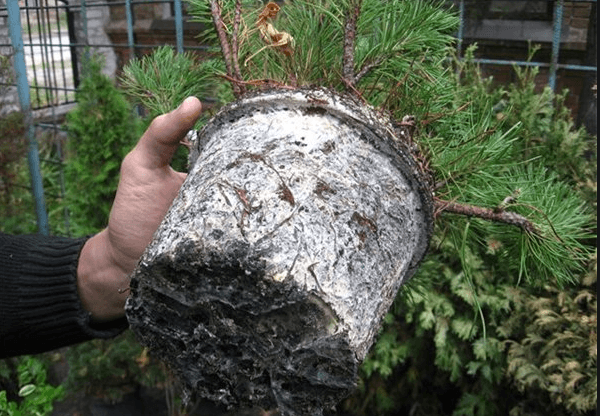
Mealybug in the roots can only be destroyed by chemical preparations.
White, fluffy, shaggy, wet neoplasms on Benjamin's ficus are sprayed with Mosplan. You can use Aktelik, characterized by intestinal-contact action. Each soluble mixture needs to be prepared, following the instructions enclosed in the instruction. On the dracenum, treatment at intervals of 4 days is continued until complete destruction of the worm.
For the processing of ornamental floral greens, you can alternately use Fazalon and Fitoverm from a mealybug. Last preparation of a biological row of insecticides of the IV generation. They can cure diseases of orchids, caused not only by the worm, but also by aphids, as well as other pests.
A number of chemical reagents supplemented by Mospilan, Confidor-maxi, Ponce. They simply get divorced: 1 g of substance per 1000 ml of water. These solutions of plants watered not too plentiful. So that there is no addiction of the pest to one poison, after 7 days watering is repeated, but already with Sperotetramat or Aplaud (from a series of new drugs). By the time of exposure to the worm, various chemical preparations are different. But, ultimately, the dried-up bodies of dead insects are necessarily found on the ground in a flower pot.

Which can only live with the help of another living organism. Parasitizing on one victim, the scarlet immediately finds the next one. Once it was used to produce red paint, but now it is known as the largest parasite in scale.
Science knows more than 2,200 species of mealybug family. On its oval body, it has a white wax, resembling flour from afar. That is why this name is given. Males of the family are usually larger than females. The average size of a mealybug is up to 6-8 mm (like a larva of a ladybug). Although its size is small, it can be found in the early stages.
What is dangerous and where does it come from
A mealybug is comparable to a time bomb for. It is dangerous because the plant easily becomes infected and quickly dies. The latter is due to the fact that the insect simply sucks the juice. The pest can be located both in the root system and in the leaf axils. Let us examine in more detail where the mealybug is taken.
So, mealybug can be found anywhere in the world. They multiply quickly. The female can lay up to 400 eggs at a time. On plants, they appear for various reasons.
For example, you yourself could bring it on clothes, of course, if you contacted an infected plant. At the same time, the option that they flew themselves was excluded: the insects belong to the order of the half-winged, whose wings are poorly developed. And female individuals are wingless.
Did you know? In sexually mature males, the mouth organ is depleted and loses its functionality.
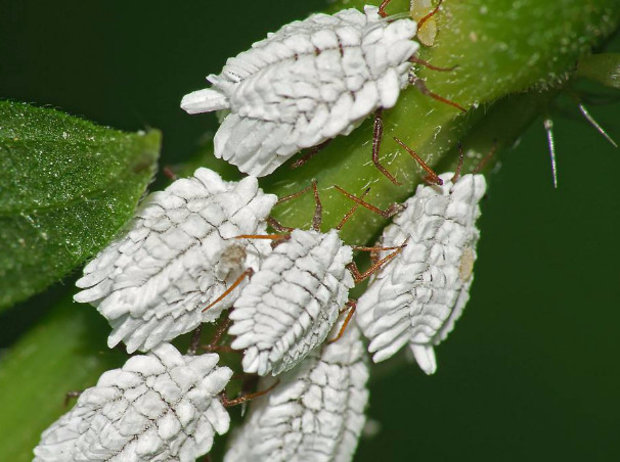
Signs of plant damage
Certainly the mealybug is dangerous, but how to fight it on, you need to know. Initially, it is necessary to determine if there is an infection on the leaves, the root system, or the shoots.
The first sign can be called the fall of the leaves or their quick drying. For example, the mealybug does not cause the stem to turn yellow. 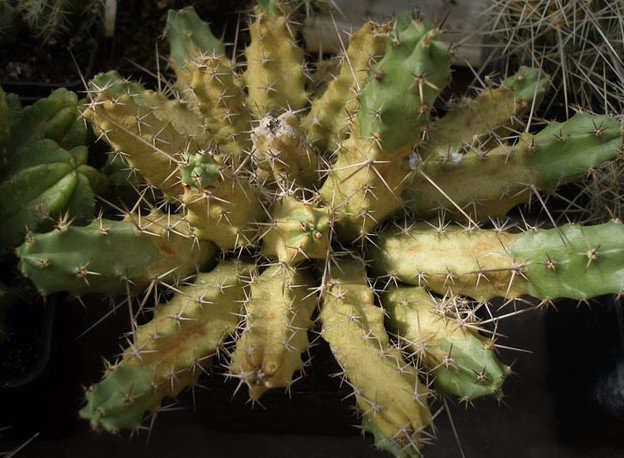
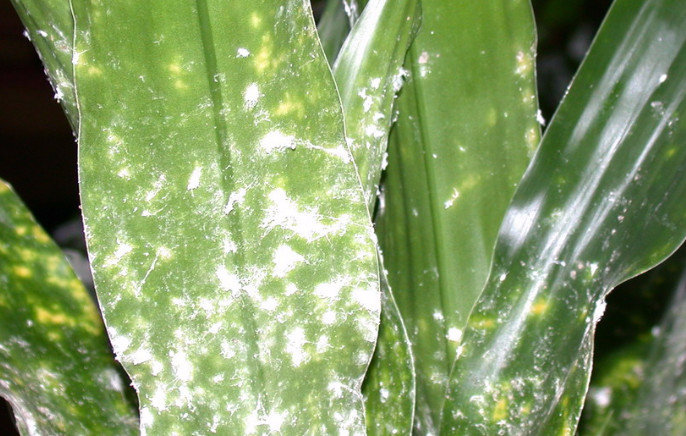 Another sign may be a cessation of growth. The mouth organ of the mealybug is piercing-sucking. It is with the help of a proboscis that he takes all the vital elements from the plant.
Another sign may be a cessation of growth. The mouth organ of the mealybug is piercing-sucking. It is with the help of a proboscis that he takes all the vital elements from the plant. In rare cases, modified flowers indicate an infection.
Risk group
A mealybug in dracaena is dangerous for one reason: the insect easily lays its eggs in places where the leaves come into contact with the stem. During treatment, you may simply not notice this fact, and all methods of struggle will be in vain. Therefore, carefully inspect the plant.
This option is also possible: they noticed an infection at the initial stage during transplantation. Then sterilize the pot. Then treat the whole plant with a liquid prepared from water (100 g of grass per 1 l of water). If the insect does not touch the roots, then wash the leaves and stem with soapy water. 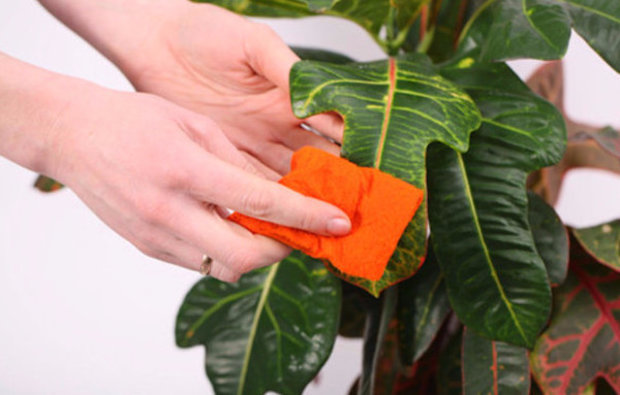
Active control measures
The mealybug does not lead to the modification of the shoots: if the infection occurred in the early stages of development, you must immediately understand how to get rid of the problem correctly.
There are two options: or folk remedies. The first will help get rid of the problem in a short time. The latter will be safe.
Chemicals
They are considered effective due to their chemical effects on larvae larvae. After all, removing an adult, you get rid of half the problem. The main thing is to remove the larvae.
Important! Chemical processing is necessary 4 times a month. One week - once. Watering clear in a week. After that, the plant has a high chance of recovery.
Folk remedies
- The solution out. You will need 1 head of garlic and 1-1.5 liters of boiling water. Crushed is filled with boiling water and infused for several hours. The plant must be wiped with a solution.
- Soap +. Any type of soap is diluted with ethyl alcohol in water. The ratio is 1: 1: 1. The main thing - to avoid falling on the substrate. The next day, carefully wipe the plant from the solution.
- . Any citrus fruit is useful for fighting insects. The peel is filled with boiling water, there are no strict restrictions in proportions. Allow the composition to cool and spray. Plus method in a pleasant smell.
Timely care and disease prevention will increase the chances that the insect will not appear. But even if such a situation has occurred, it is worth assessing the damage as soon as possible and undertaking the above described methods of struggle.
Was this article helpful?
Well no
Have you ever noticed on your home plants white, as if sprinkled with flour, bugs with many paws and long antennae? If yes, it's time to sound the alarm - your green pet has been attacked mealybugs (or shaggy louse, as they say), one of the most dangerous insect pests.
Signs of Mealybug Infection
In order to accurately recognize the mealybug, carefully examine the flower. Here are the main symptoms:
- the plant is covered with white bloom and as if sprinkled with flour
- on the leaves, shoots or buds - sticky mucus, the so-called honeydew or dew
- all parts of the plant are covered with insects with white oval bodies
- flower looks sluggish, drooping, leaves lose turgor
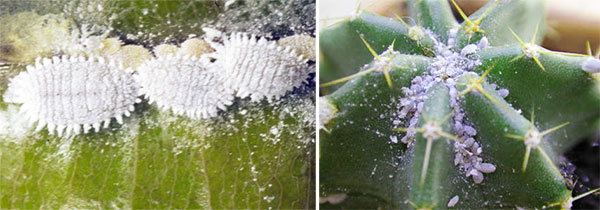
What a mealybug looks like
Mealybugs (Pseudococcidae) come from the family of hemiptera or arthropods, the superfamily of the worms.
Insects have quite a few subspecies, and there are both viviparous insects and worms laying eggs. All of them are united by common external signs, and the appearance of pests varies with age and gender. For example, females and males are significantly different from each other. The mealybug female is an insect with an oval-shaped body covered with a white patina, many short legs and a long, filiform antennae. The size of the female varies from three to five millimeters, depending on the species. The larva (nymph) looks about the same as the female, but differs in smaller sizes. The males of the mealybug are significantly different from the females: they are winged insects, similar to mosquitoes or flies. Males do not harm the plant, because they do not feed on them, the males do not have an oral apparatus.
[!] In farmsteads and agriculture, mealybugs are also one of the most common and difficult to remove insect pests. The main objects of the insect's attack are fruit bushes (currant, gooseberry, sea buckthorn) and rose flowers (hawthorn, dogrose, rose).

Causes of mealybug
It is impossible to unequivocally answer the question: where do mealybugs come from? There are several reasons and all of them are connected with improper care and maintenance of the plant:
1. Errors associated with watering: waterlogging or, conversely, excessive drying of soil
2. Errors related to temperature, humidity and illumination of the location of the plant: too low temperature, insufficient air humidity, low amount of natural light.
3. Errors associated with the general content and hygienic procedures: the lack of periodic inspection of the plant, late removal of dead buds, leaves and shoots, lack of water procedures, such as the soul, for the plant.
4. Ignoring the quarantine of newly acquired plants.
The mealybug attacks are particularly susceptible to various palms, cacti, citrus fruits, ivy and ferns.
Types of Mealybug
In the world there are about two thousand species of worms that live mainly in countries with warm and humid climates. Fortunately, the territory of Russia was chosen only by a few species of worm. Let's look at them in more detail.
Seaside Mealybug (Pseudococcus affinis) is the most common type of mealybug. Females and males are significantly different from each other. Males are small flying insects that move from a plant to a plant and do not harm it. Females have a rather large size (up to 4 mm. In length), the legs are well developed, and the body is covered with white or white and pink bloom. Throughout their life, females of seaside mealybugs lay eggs in the so-called egg bags and carefully hide them in hard-to-reach places: in the sinuses of leaves, between shoots and even, in the presence of a cracked trunk, in cracks of the bark. The larvae hatched from the egg are small yellowish insects. Unlike females, there is no plaque on the body of the larva. About a month after hatching, adult larvae begin to fully feed on the plant and, accordingly, gradually destroy it.
Bristly mealybug (Pseudococcus longispinus) looks approximately the same as the seaside one, but differs in slightly smaller sizes (length of the female body is about 3 mm.). This species of worm is viviparous, females do not lay eggs. Bristleworms prefer to stray into numerous groups and hide in inaccessible places on the plant. Pests can even live and feed on root bulbs, hiding behind bulbous scales.
Grape mealybug (Pseudococcus citri) in its appearance is similar to both seaside and bristly worms. Like the seaside, the grape scarlet is egg-laying - the larvae hatch from the eggs. The method of settling colonies on a plant is similar to the previous species.
Citrus Mealybug (Pseudococcus calceolariae). Adult females reach 4 mm. in length, the body is light pink, covered with white bloom.
Rootbird (Rhizoecus falcifer) - females of white color, body length about 2 mm. This species is distinguished by the fact that it prefers to live and eat on the roots of a plant, without neglecting, however, the aboveground part, leaves, shoots, and buds. The friable and dry soil is an excellent environment for the development of the root-bite, as a result of which cacti grown in such a substrate are particularly susceptible to root-bite attacks.
Comstock Cape (Pseudococcus comstocki) - an insect reaching 5 mm. in length. Practically not found on the territory of modern Russia, but it can still be seen in certain areas of Central Asia and the Caucasus.
Preventive measures
In order for your home plant not to become infected with a mealy bug, it is necessary to periodically carry out prophylaxis, which includes:
- Careful inspection of the plant. Remember that pests are able to skillfully hide, for example, on the back of a leaf of a plant, in young shoots, unopened buds and other hard-to-reach places.
- Timely removal of dried plant parts: dry branches, leaves and buds are very attractive to mealybugs. Remove them on time, do not leave insects a chance to find a comfortable shelter.
- Water activities such as timely and sufficient watering, periodic showers or washing the leaves. The mealybug does not like a wet environment, preferring to settle in dry areas. That is why the periodic rinsing of the plant and the moistening of the soil are so important. It is important not to overdo it, because many other insect pests, such as sub-hens, on the contrary, prefer a moist environment.
- Quarantine measures. Each new plant that enters your home should be placed on a quarantine: for a while, isolate it from other colors and carry out preventive treatment with universal preparations. Read more about quarantine in.
If, despite all the preventive measures, the mealybug still appeared on your green pet, start a merciless fight against it as soon as possible. If the worm colony is not yet large, try the more benign (folk) methods first. But, if the mealybug is settled on the plant in large numbers, unfortunately, we cannot do without modern chemical preparations.
Mealybug - how to fight
Traditional methods of struggle with mealybug
There are a sufficiently large number of recipes for pest control, consisting of household components. Let's look at some of them:
1. Soap solution. It is best to use green soap to prepare the solution, if there is no such possibility - the usual solid, liquid or economic solution will do. To prepare the solution, stir 15 gr. solid or 15 ml. liquid soap in a liter of water. The resulting preparation to spray the plant at least three times with a weekly interval, washing the solution a day after each treatment. To enhance the effect in the resulting mixture, you can add 1-2 tablespoons of alcohol or vodka.
2. Herbal tinctures. Crushed powder of calendula or horsetail (sold in pharmacies) to brew boiling water, cool and process the plant. Recommended proportions - 100 gr. calendula (horsetail) on 1 liter. water.
3. Olive oil with water. Rather sparing for a plant, mix 2 tbsp. spoons of olive oil and a liter of water and apply the solution from the spray. After about one to two hours, wash off the emulsion.
4. Garlic infusion. On a liter of water take 5-6 teeth of garlic. Crush garlic, pour boiling water and infuse for four hours. Filter the resulting mixture and, using a brush or soft cloth, apply to the trunk, shoots and leaves.
5. Tincture orange peel and lemon. Orange and lemon peel pour boiling water in a ratio of 30-50 grams. zest per liter of water, let stand for a day and process the plant from a spray bottle.
6. When dealing with a root scarlet, treating the roots of a plant with hot water helps well. Remove the flower from the pot, shake the roots off the ground and place in a large pot of hot water (about 55 ° C) so that the water covers only the roots without affecting the aboveground part. Hold the plant in the pan for at least 15 minutes, then dry the roots and transplant in a new container with a fresh substrate.
Powderworm Chemicals
Currently, especially for the control of insect pests, a large number of preparations are being produced, many of which are well known to gardeners and home plant lovers. The following insecticides have proven themselves in the destruction of mealybugs:
- Aktara
- Actellic
- Fitoderm
- Konfidor Extra
- Bi-58
- Spark Gold
- Aplaud
When using chemical preparations, carefully study the instructions in which the necessary dosages and method of administration are prescribed. It is important to follow the instructions and recommendations of the manufacturer.
[!] Some drugs, such as Actellic, are highly toxic and can threaten the health of people and animals. Therefore, it is very important to observe all recommended precautions: carry out the treatment in rubber gloves and in the open air. Keep children and animals away from the treated plant!
Note the importance of repeating treatment after 7-10 days. The fact is that almost all chemicals destroy only adult mealybugs and hatched larvae, they do not act on the egg-laying. If you ignore the reprocessing, a new generation of insects, which appeared from the eggs, after some time again attacks the plant.
It is also important to change insecticides from time to time, since mealybugs may develop immunity to a particular poison.
There is another way to combat the mealybug biological. This method is hardly suitable for amateur growers, rather it is applicable for large greenhouses or home farms, but it should be noted.
The fact is that there are natural (natural) enemies of the mealybug, feeding on them in the wild, the so-called entomophages. This, for example, ladybugs, golden-eyed, anthocice bugs, spiders, various riders. All of these insects regulate the number of worms, and even completely exterminate colonies of pests. That is why it is very important not to destroy entomophages in your garden plot.
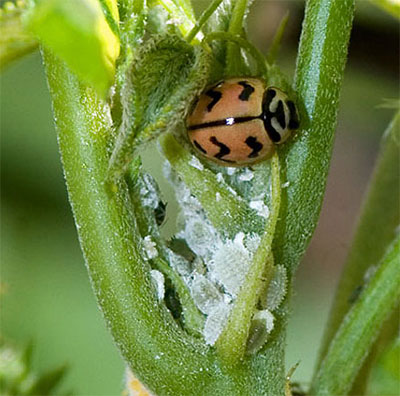
We tell in detail how to deal with a mealybug in indoor plants: control methods, effective preparations and folk remedies, as well as the secrets of experienced flower growers.
How to deal with mealybug in indoor plants?
Pests on indoor plants gives us unpleasant emotions. And we want you to be joyful and fun - so see our advice.
Experts recommend to deal with the mealybug in the indoor plants in a complex. With a small defeat of the flower to fight the pest is easy and you can try to do with folk remedies, and with a strong defeat it is better to use drugs.
In any case, to get rid of the mealybug, you need to carefully follow the recommendations of experts and experienced flower growers.
TIPS. Types of plants in which you can not wash the leaves need to be sprayed, and better drugs.
In case of a pest damage to the root system, gently rinse the roots and cut off the damaged areas, and then transplant the plant into a new substrate.
Treatment of mealybugs is often quite a long process, which can take 6-12 months.
Mealybug close up
Mealworm remedy
Meals from the mealybug on the indoor plants are chemical and folk, which have their own advantages and disadvantages. Many experienced growers believe that insecticides are more effective means.
In order to get rid of the mealybug it is necessary to use preparations of intestinal, and not contact action. According to experts, systemic insecticides do well.
Popular drugs
We present popular preparations for mealybugs and indicate the hazard (toxicity) class: 4 - low danger to humans, safe for bees and beneficial insects, 3 - moderately hazardous substance, 2 - highly dangerous substance, 1 - extremely dangerous for humans and animals.
We also indicate the active ingredient and the approximate prices of funds in Russia.
- "Akarin" (the old name "Agravertin") - 4, (avertin), price: 4 ml package - 13-20 rubles.
- "Aktara" - 3, (thiamethoxam), price: 1.2 ml ampoule - 40-50 rubles, a package of 4 grams - 90-120 rubles.
- "Actellic" - 2, (pyrimiphos-methyl), price: 2 ml package - 30-50 rubles. In Russia, the drug for personal use is not registered on 01.10.2016. Although sometimes the drug can still be found in small shops and on the Internet.
- “Bankol” - 3 (bensultap), price: a package of 10 grams - 30-40 rubles.
- "Vertimek" - 2, (abamectin), price: $ 90 / liter, manual packaging - 2 ml - 25 rubles.
- "Inta-Vir" - 3, (cypermethrin), price: package 8 g - 10-15 rubles.
- "Karbofos" ("Malathion", "Fufanon") - 3, (Malathion), price: a package of 30 grams - 30-40 rubles (a sharp unpleasant smell).
- “Konfidor Extra” - 3, (imidacloprid), price: package 1 gr - 30-40 rubles.
- "Tanrek" - 3, (imidacloprid), price: 1 ml ampoule - 10-15 rubles.
- “Fitoverm” - 4, (aversectin C), price: package (ampoule) 4ml - 15-20 rubles.
- Prices are based on hypermarkets of the type “Obi”, “Leroy Merlin” according to the exchange rate of 1 dollar = 65 rubles. These drugs are widely found in many flower shops.
How to choose a drug?
With a strong defeat of the plant, it is not easy to get rid of the mealy worm. It is necessary to try and select an effective insecticide individually, so that the pest does not have time to get used to the active substance.
Therefore, look for reliable mealybug preparations on houseplants that have received positive feedback and recommendations from specialists.
- Magazine “Holiday of Flowers” recommends starting the fight against mealybugs with the preparation “Fitoverm”, which is as safe as possible for humans and animals, or “Aktar” - a powerful systemic insecticide.
If you do not find these drugs or decreased effectiveness, then use "Inta-Vir" or "Tanrek" / "Confidor". All of these drugs can be alternated if necessary.
And in case of severe damage or weak effects of previous drugs, use Actellic or Karbofos, Vertimec as they are more toxic.
"Karbofos", "Vertimemekom" and "Aktellik" can be used to process indoor plants only outdoors.
ATTENTION! Carefully read the instructions for use of any drug and follow the manufacturer's recommendations.
Now you know an effective remedy for mealybug on indoor flowers, and we’ll take a closer look at some of them.
"Fitoverm" from mealybug
"Fitoverm" is a popular and effective tool in the fight against mealybug. He in many situations well helps to get rid of the pest on indoor plants.
Florists wishing to use low-toxic drugs, we recommend it to use first.
“Fitoderm” is an insecticoacaricide of biological origin with minimal danger to humans and domestic animals.
- To get rid of the mealybug, dissolve 2 ml of the preparation in 200 ml of water and spray the indoor flower. Treatments are carried out every 5-8 days, depending on the size and age of the home plant, as well as air temperature.
In most cases, 3-4 procedures are sufficient. Some growers process "Fitoverm" against the mealybug each 5 days three times and completely destroy the pest.
A week after the last or the next spraying of "Fitoverm", the plant can be treated with "Epinom" to support the indoor flower.
"Aktara" from mealybug
Aktara is a very powerful systemic insecticide that destroys the mealybug in most cases.
A room flower is sprayed with the Aktara solution with 1 gram per 1.25 liter of water (enough for 25-30 plants) and the soil mixture is shed - 1 gram per 10 liters of water.
The procedure should be carried out 2-4 times, every 10-12 days, depending on the air temperature. In most cases, after 2-3 procedures, it turns out to bring out a mealy worm.
After spraying the flower "Aktar" do not need to be washed off. The waiting period when spraying is 1-24 hours, and when watering - 2-4 days.
Due to the simultaneous spraying and irrigation of the soil "Aktaroy", the active ingredient of the drug (thiamethoxam) kills the mealybug on homemade flowers.
"Konfidor" from the mealybug
To destroy the mealybug, you can use "Konfidor": dilute 1 g of the drug in 500 ml of water (1 ml per 2.5 liters of water) and spray the plant with the top layer of soil.
According to the reviews of flower growers in 3-4 hours the mealybug perishes, and the product does not harm the plants. Additionally, it is better to shed the soil with a weaker twofold solution.
The drug with a strong defeat: "Aktellik"
Dilute the ampoule (2 ml) in a liter of water and spray during the appearance of the mealybug. No more than 2-3 consecutive treatments. The waiting time is 3 days.
IMPORTANT! "Actellic" can only be used outdoors. It is impossible to work with it to pregnant women, people suffering from asthma and allergic diseases.
Treatment plan
- Treat the plant with insecticides 3-4 times every 7-8 days with an average daily temperature of 22-24 °, and when the temperature is higher (25-28 °), then after 5-6 days. With an average temperature of 15-20 ° - 8-10 days, and if below 15 ° - 10-12 days.
- If the air temperature at the time of treatment is below 18 °, then the effectiveness of preparations for mealybugs is significantly reduced, and it makes little sense to spray indoor plants.
- After spraying the plant does not need to wear a plastic transparent bag, it is much more important to re-process at the right time.
- A single treatment with any drug will give a one-time effect - therefore, you need to deal with a mealy bug systematically.
IMPORTANT! In case of detection of a mealybug, it is desirable to process all indoor plants, if you process only a part of the home collection, then there is a high risk of repeated detection of the pest.
TIPS. These countermeasures are also suitable for the destruction of the false guard and shield.
How to treat plants with drugs?
- Individual protection measures (skin, respiratory organs) when working with chemical preparations against mealybugs. After the procedure, wash your hands and face with soap and rinse your throat and nose with water.
- Treat the indoor flower only dry.
- Better processing time - until 12.00. On a cloudy day, until 14.00. During and after spraying before drying the plant, it should not fall direct sunlight.
- The optimum temperature is 20-26 degrees Celsius.
- The place for treatment of a flower with preparations of the 3rd and 4th class of danger may be a balcony or a bathroom, and preparations of the 2nd class can only be used outdoors.
- To maximize the effect of spraying with the agent, it is recommended to add liquid potassium soap to the solution.
- Be sure to well ventilate the room after using drugs.
IMPORTANT! Carefully read the instructions of the drug - consumption rates may differ from the above, as they are often produced in liquid and dry form, in different concentrations of active substances or package size.
Tick and flea cleanser
Means from fleas and ticks with the active substance, imidacloprid (finpronil, cypermethrin), effectively help flea mealybug on potted plants. For example, drops - "Advantiks" (550 rubles), "Outpost" (250 rubles).
After 1, 2, 3 points from the general instruction.
- Droplets mix with water: a small pipette of 500 ml, and a large one in a liter of warm water.
- Dampen the leaves, sinuses, petioles and stem of the plant, as well as the top layer of the substrate with this emulsion.
- After the solution has dried, air the room. The solution can not rinse, and with a strong smell can be washed off every other day with water.
As a rule, one procedure is enough; if necessary, repeat after a week.
If you can not re-process the plant, then you can cover the plant pot with a bag (trash) and leave a gap. Through it, spray the plant for 3-4 seconds with the “Bolfo” aerosol (400 rubles), tie up the bag and leave the flower for 24 hours - the mealybug will suffocate.
IMPORTANT! All procedures are carried out only in the open air or balcony!
- The preparations "Tanrek" and "Confidor" contain a similar active ingredient, so you can safely apply them.
How to get rid of mealybug folk remedies?
Specialists refer to folk remedies in the fight against mealybugs in different ways. Many growers complain that folk remedies are extremely inefficient, and moreover they can harm the plant.
The editors of the magazine "Holiday of Flowers" believe that folk remedies for mealybug in certain situations can be used because they are safer for humans and animals.
If the degree of damage to the flower is small and there are not so many pests, then it is better to start treatment with folk remedies. And also if it is a plant that can be donated, and the desire to buy insecticides because of it is not.
In any case, the use of folk remedies for mealybugs on indoor plants is a personal choice of each grower, but systemic insecticides are more effective.
1. Soap solution
To prepare a soap solution suitable household, tar or green potassium soap, and, in extreme cases, suitable dishwashing detergent.
Soap solution needs to process the entire home plant, as well as the window sill, window frame, pot and pot tray. The more foam in the process, the better.
After rubbing the flower, it is better to wash off the soap suds in 2-4 hours.
RECIPE. Tablespoon of soap chips, pour a glass of warm water. To enhance the effect, you can add a teaspoon of ammonia (technical, medical, in extreme cases, vodka) and 300 grams of water.
The soap-alcohol solution must be washed off with 10–15 minutes of warm water so as not to burn the house flower.
IMPORTANT! Some experts insist that the use of soap solution on room flowers is not acceptable. In their opinion, the soap blocks the stomata of the plant, which leads to disruption of photosynthesis and plant development.
Alcohol can not handle plants with delicate leaves.
2. Garlic
Garlic infusion is a popular folk remedy in the fight against various pests.
Fill a glass of water with five crushed teeth (a teaspoon of gruel) of garlic. Insist the mixture in a tightly sealed container for 1-2 days, and then wash the plant every 7-8 days. To spray - strain the infusion through three layers of gauze.
Recipe number 2. A teaspoon of gruel of garlic (4-5 teeth of crush) fall asleep in 500 ml of boiling water and insist 4-5 hours. Infusion filter and wipe the affected flower.
3. Onions
A medium bulb is finely chopped, pounded and poured with a glass of water for 2-3 hours. Then everything, as with garlic.
ONION GROUND. To prepare the infusion, 20 grams of husk is poured with a liter of warm water and insisted for 13-16 hours. The resulting infusion is sprayed with indoor flowers, usually 2-3 procedures are enough to remove aphids.
4. Pepper infusion
Infusion of red hot pepper: 20-30 grams of chopped (finely chopped) pepper boil in 200 ml of water for 60 minutes. Then infuse the resulting liquid for 24 hours and strain. For spraying 10 ml of infusion diluted in a liter of water.
Treating plants infusion of pepper can be every two weeks. Pepper tincture can be stored for a long time in finished form, which allows it to be applied very quickly.
5. Oil
Whisk 5-10 grams of soap in a glass of water until foam appears in the glass; add 15-20 ml of engine oil (2 tablespoons of olive or sunflower oil). Soap-oil emulsion washed the plant completely and incubated for 6-10 hours, and then washed off.
Conduct 2-3 procedures in 7-10 days. Before processing the plant - cover the soil mixture in the pot with a film! Treatment with water-oil emulsion is not recommended for plants with pubescent, tender and very thin leaves.
6. Kerosene
In a liter of water, 40 grams of household soap are stirred (25 grams of green potash) and five drops of kerosene are added, and then the solution is shaken well. The mixture can wipe or spray the affected areas of the plant.
7. Tobacco
80 grams of dry tobacco (shag), pour a liter of water and leave for 24 hours, then strain and dilute with a liter of water. Then rinse and spray the plant.
8. Calendula
With a tampon dipped in calendula tincture, rub the affected areas every evening for 3-4 days in a row.
BIOLOGICAL METHOD
To combat the mealybug, some use mushroom and bacterial preparations (microbiological), for example, Lepodotsid.
Pest prevention at home
The best remedy for mealybugs on indoor plants is to regularly inspect pets: especially carefully examine the leaf bosoms, the stem, and the inside and outside of the leaves.
At home, the pest is depressed by airing the room, spraying and washing the leaves of plants, as the mealybug loves dry air and is afraid of moisture.
Do not allow the situations described in the section “Where the Mealy Chew comes from” from the supplementary article.
SUPPLEMENT TO ARTICLE:
The pest review has come to an end. We hope that now you will be able to deal with the mealybug in indoor plants with the help of drugs (insecticides) or folk remedies more effectively.
And the main thing is to get rid of the mealybug and enjoy the plants you love!

